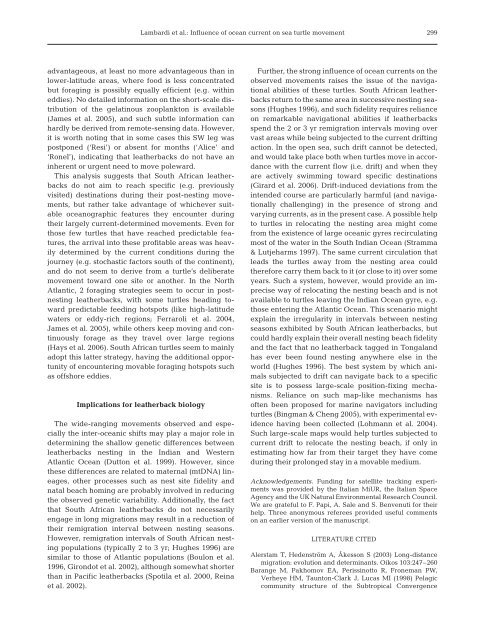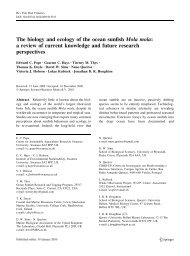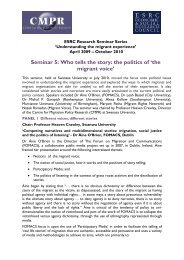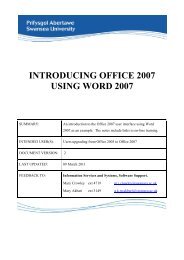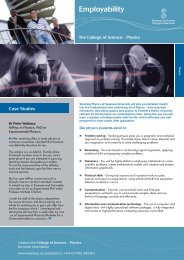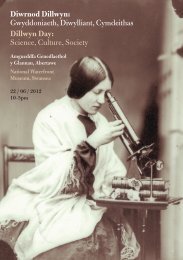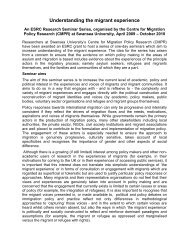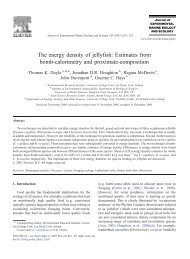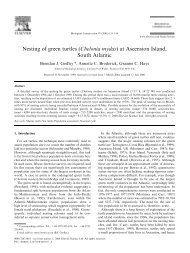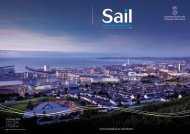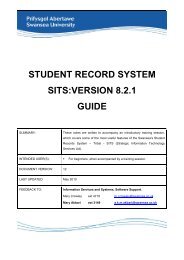Marine Ecology Progress Series 353:289
Marine Ecology Progress Series 353:289
Marine Ecology Progress Series 353:289
You also want an ePaper? Increase the reach of your titles
YUMPU automatically turns print PDFs into web optimized ePapers that Google loves.
Lambardi et al.: Influence of ocean current on sea turtle movement<br />
299<br />
advantageous, at least no more advantageous than in<br />
lower-latitude areas, where food is less concentrated<br />
but foraging is possibly equally efficient (e.g. within<br />
eddies). No detailed information on the short-scale distribution<br />
of the gelatinous zooplankton is available<br />
(James et al. 2005), and such subtle information can<br />
hardly be derived from remote-sensing data. However,<br />
it is worth noting that in some cases this SW leg was<br />
postponed (‘Resi’) or absent for months (‘Alice’ and<br />
‘Ronel’), indicating that leatherbacks do not have an<br />
inherent or urgent need to move poleward.<br />
This analysis suggests that South African leatherbacks<br />
do not aim to reach specific (e.g. previously<br />
visited) destinations during their post-nesting movements,<br />
but rather take advantage of whichever suitable<br />
oceanographic features they encounter during<br />
their largely current-determined movements. Even for<br />
those few turtles that have reached predictable features,<br />
the arrival into these profitable areas was heavily<br />
determined by the current conditions during the<br />
journey (e.g. stochastic factors south of the continent),<br />
and do not seem to derive from a turtle’s deliberate<br />
movement toward one site or another. In the North<br />
Atlantic, 2 foraging strategies seem to occur in postnesting<br />
leatherbacks, with some turtles heading toward<br />
predictable feeding hotspots (like high-latitude<br />
waters or eddy-rich regions; Ferraroli et al. 2004,<br />
James et al. 2005), while others keep moving and continuously<br />
forage as they travel over large regions<br />
(Hays et al. 2006). South African turtles seem to mainly<br />
adopt this latter strategy, having the additional opportunity<br />
of encountering movable foraging hotspots such<br />
as offshore eddies.<br />
Implications for leatherback biology<br />
The wide-ranging movements observed and especially<br />
the inter-oceanic shifts may play a major role in<br />
determining the shallow genetic differences between<br />
leatherbacks nesting in the Indian and Western<br />
Atlantic Ocean (Dutton et al. 1999). However, since<br />
these differences are related to maternal (mtDNA) lineages,<br />
other processes such as nest site fidelity and<br />
natal beach homing are probably involved in reducing<br />
the observed genetic variability. Additionally, the fact<br />
that South African leatherbacks do not necessarily<br />
engage in long migrations may result in a reduction of<br />
their remigration interval between nesting seasons.<br />
However, remigration intervals of South African nesting<br />
populations (typically 2 to 3 yr; Hughes 1996) are<br />
similar to those of Atlantic populations (Boulon et al.<br />
1996, Girondot et al. 2002), although somewhat shorter<br />
than in Pacific leatherbacks (Spotila et al. 2000, Reina<br />
et al. 2002).<br />
Further, the strong influence of ocean currents on the<br />
observed movements raises the issue of the navigational<br />
abilities of these turtles. South African leatherbacks<br />
return to the same area in successive nesting seasons<br />
(Hughes 1996), and such fidelity requires reliance<br />
on remarkable navigational abilities if leatherbacks<br />
spend the 2 or 3 yr remigration intervals moving over<br />
vast areas while being subjected to the current drifting<br />
action. In the open sea, such drift cannot be detected,<br />
and would take place both when turtles move in accordance<br />
with the current flow (i.e. drift) and when they<br />
are actively swimming toward specific destinations<br />
(Girard et al. 2006). Drift-induced deviations from the<br />
intended course are particularly harmful (and navigationally<br />
challenging) in the presence of strong and<br />
varying currents, as in the present case. A possible help<br />
to turtles in relocating the nesting area might come<br />
from the existence of large oceanic gyres recirculating<br />
most of the water in the South Indian Ocean (Stramma<br />
& Lutjeharms 1997). The same current circulation that<br />
leads the turtles away from the nesting area could<br />
therefore carry them back to it (or close to it) over some<br />
years. Such a system, however, would provide an imprecise<br />
way of relocating the nesting beach and is not<br />
available to turtles leaving the Indian Ocean gyre, e.g.<br />
those entering the Atlantic Ocean. This scenario might<br />
explain the irregularity in intervals between nesting<br />
seasons exhibited by South African leatherbacks, but<br />
could hardly explain their overall nesting beach fidelity<br />
and the fact that no leatherback tagged in Tongaland<br />
has ever been found nesting anywhere else in the<br />
world (Hughes 1996). The best system by which animals<br />
subjected to drift can navigate back to a specific<br />
site is to possess large-scale position-fixing mechanisms.<br />
Reliance on such map-like mechanisms has<br />
often been proposed for marine navigators including<br />
turtles (Bingman & Cheng 2005), with experimental evidence<br />
having been collected (Lohmann et al. 2004).<br />
Such large-scale maps would help turtles subjected to<br />
current drift to relocate the nesting beach, if only in<br />
estimating how far from their target they have come<br />
during their prolonged stay in a movable medium.<br />
Acknowledgements. Funding for satellite tracking experiments<br />
was provided by the Italian MiUR, the Italian Space<br />
Agency and the UK Natural Environmental Research Council.<br />
We are grateful to F. Papi, A. Sale and S. Benvenuti for their<br />
help. Three anonymous referees provided useful comments<br />
on an earlier version of the manuscript.<br />
LITERATURE CITED<br />
Alerstam T, Hedenström A, Åkesson S (2003) Long-distance<br />
migration: evolution and determinants. Oikos 103:247–260<br />
Barange M, Pakhomov EA, Perissinotto R, Froneman PW,<br />
Verheye HM, Taunton-Clark J, Lucas MI (1998) Pelagic<br />
community structure of the Subtropical Convergence


